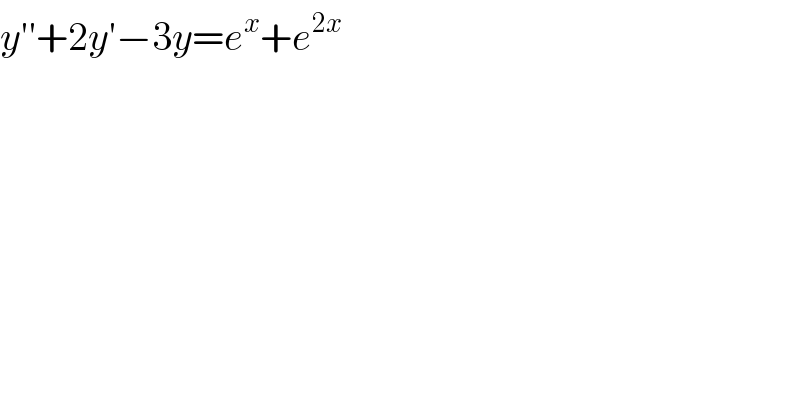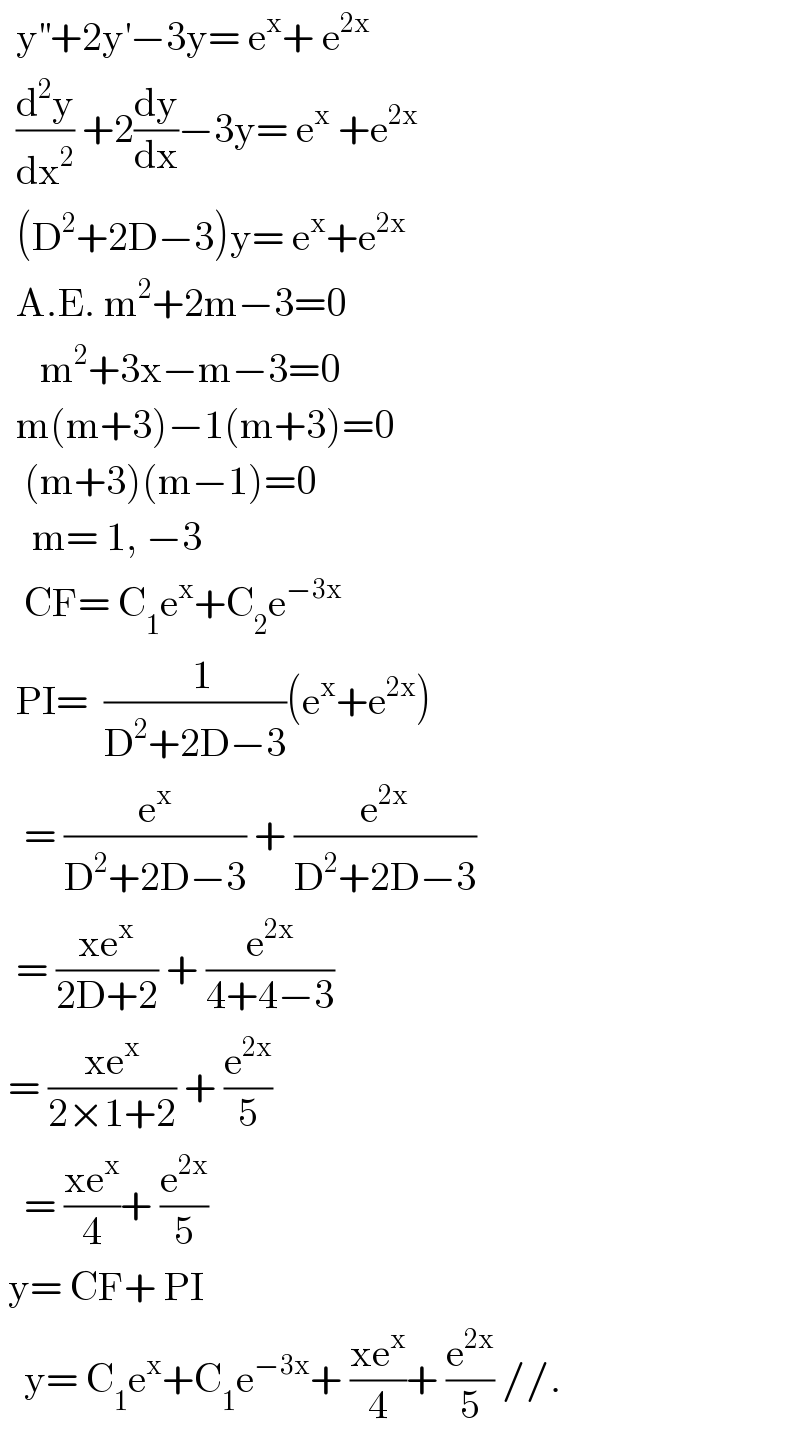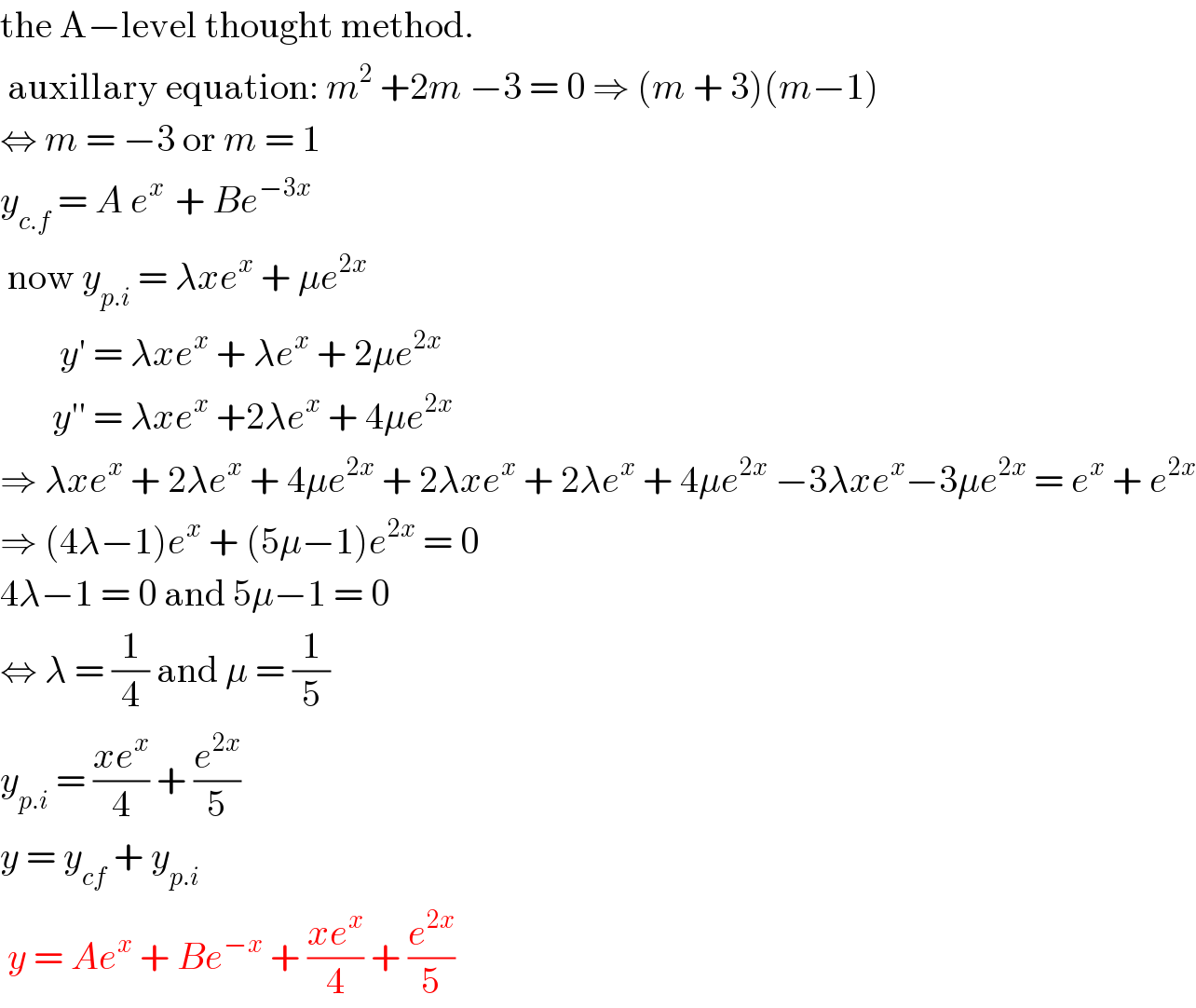Question Number 92702 by i jagooll last updated on 08/May/20

$${y}''+\mathrm{2}{y}'−\mathrm{3}{y}={e}^{{x}} +{e}^{\mathrm{2}{x}} \\ $$
Answered by niroj last updated on 08/May/20

$$\:\:\mathrm{y}^{''} +\mathrm{2y}^{'} −\mathrm{3y}=\:\mathrm{e}^{\mathrm{x}} +\:\mathrm{e}^{\mathrm{2x}} \\ $$$$\:\:\frac{\mathrm{d}^{\mathrm{2}} \mathrm{y}}{\mathrm{dx}^{\mathrm{2}} }\:+\mathrm{2}\frac{\mathrm{dy}}{\mathrm{dx}}−\mathrm{3y}=\:\mathrm{e}^{\mathrm{x}} \:+\mathrm{e}^{\mathrm{2x}} \\ $$$$\:\:\left(\mathrm{D}^{\mathrm{2}} +\mathrm{2D}−\mathrm{3}\right)\mathrm{y}=\:\mathrm{e}^{\mathrm{x}} +\mathrm{e}^{\mathrm{2x}} \\ $$$$\:\:\mathrm{A}.\mathrm{E}.\:\mathrm{m}^{\mathrm{2}} +\mathrm{2m}−\mathrm{3}=\mathrm{0} \\ $$$$\:\:\:\:\:\mathrm{m}^{\mathrm{2}} +\mathrm{3x}−\mathrm{m}−\mathrm{3}=\mathrm{0} \\ $$$$\:\:\mathrm{m}\left(\mathrm{m}+\mathrm{3}\right)−\mathrm{1}\left(\mathrm{m}+\mathrm{3}\right)=\mathrm{0} \\ $$$$\:\:\:\left(\mathrm{m}+\mathrm{3}\right)\left(\mathrm{m}−\mathrm{1}\right)=\mathrm{0} \\ $$$$\:\:\:\:\mathrm{m}=\:\mathrm{1},\:−\mathrm{3} \\ $$$$\:\:\:\mathrm{CF}=\:\mathrm{C}_{\mathrm{1}} \mathrm{e}^{\mathrm{x}} +\mathrm{C}_{\mathrm{2}} \mathrm{e}^{−\mathrm{3x}} \\ $$$$\:\:\mathrm{PI}=\:\:\frac{\:\:\mathrm{1}}{\mathrm{D}^{\mathrm{2}} +\mathrm{2D}−\mathrm{3}}\left(\mathrm{e}^{\mathrm{x}} +\mathrm{e}^{\mathrm{2x}} \right) \\ $$$$\:\:\:=\:\frac{\mathrm{e}^{\mathrm{x}} }{\mathrm{D}^{\mathrm{2}} +\mathrm{2D}−\mathrm{3}}\:+\:\frac{\mathrm{e}^{\mathrm{2x}} }{\mathrm{D}^{\mathrm{2}} +\mathrm{2D}−\mathrm{3}} \\ $$$$\:\:=\:\frac{\mathrm{xe}^{\mathrm{x}} }{\mathrm{2D}+\mathrm{2}}\:+\:\frac{\mathrm{e}^{\mathrm{2x}} }{\mathrm{4}+\mathrm{4}−\mathrm{3}} \\ $$$$\:=\:\frac{\mathrm{xe}^{\mathrm{x}} }{\mathrm{2}×\mathrm{1}+\mathrm{2}}\:+\:\frac{\mathrm{e}^{\mathrm{2x}} }{\mathrm{5}} \\ $$$$\:\:\:=\:\frac{\mathrm{xe}^{\mathrm{x}} }{\mathrm{4}}+\:\frac{\mathrm{e}^{\mathrm{2x}} }{\mathrm{5}} \\ $$$$\:\mathrm{y}=\:\mathrm{CF}+\:\mathrm{PI} \\ $$$$\:\:\:\mathrm{y}=\:\mathrm{C}_{\mathrm{1}} \mathrm{e}^{\mathrm{x}} +\mathrm{C}_{\mathrm{1}} \mathrm{e}^{−\mathrm{3x}} +\:\frac{\mathrm{xe}^{\mathrm{x}} }{\mathrm{4}}+\:\frac{\mathrm{e}^{\mathrm{2x}} }{\mathrm{5}}\://. \\ $$
Answered by Rio Michael last updated on 08/May/20

$$\mathrm{the}\:\mathrm{A}−\mathrm{level}\:\mathrm{thought}\:\mathrm{method}. \\ $$$$\:\mathrm{auxillary}\:\mathrm{equation}:\:{m}^{\mathrm{2}} \:+\mathrm{2}{m}\:−\mathrm{3}\:=\:\mathrm{0}\:\Rightarrow\:\left({m}\:+\:\mathrm{3}\right)\left({m}−\mathrm{1}\right)\: \\ $$$$\Leftrightarrow\:{m}\:=\:−\mathrm{3}\:\mathrm{or}\:{m}\:=\:\mathrm{1} \\ $$$${y}_{{c}.{f}} \:=\:{A}\:{e}^{{x}\:} \:+\:{Be}^{−\mathrm{3}{x}} \\ $$$$\:\mathrm{now}\:{y}_{{p}.{i}} \:=\:\lambda{xe}^{{x}} \:+\:\mu{e}^{\mathrm{2}{x}} \\ $$$$\:\:\:\:\:\:\:\:{y}'\:=\:\lambda{xe}^{{x}} \:+\:\lambda{e}^{{x}} \:+\:\mathrm{2}\mu{e}^{\mathrm{2}{x}} \\ $$$$\:\:\:\:\:\:\:{y}''\:=\:\lambda{xe}^{{x}} \:+\mathrm{2}\lambda{e}^{{x}} \:+\:\mathrm{4}\mu{e}^{\mathrm{2}{x}} \\ $$$$\Rightarrow\:\lambda{xe}^{{x}} \:+\:\mathrm{2}\lambda{e}^{{x}} \:+\:\mathrm{4}\mu{e}^{\mathrm{2}{x}} \:+\:\mathrm{2}\lambda{xe}^{{x}} \:+\:\mathrm{2}\lambda{e}^{{x}} \:+\:\mathrm{4}\mu{e}^{\mathrm{2}{x}} \:−\mathrm{3}\lambda{xe}^{{x}} −\mathrm{3}\mu{e}^{\mathrm{2}{x}} \:=\:{e}^{{x}} \:+\:{e}^{\mathrm{2}{x}} \\ $$$$\Rightarrow\:\left(\mathrm{4}\lambda−\mathrm{1}\right){e}^{{x}} \:+\:\left(\mathrm{5}\mu−\mathrm{1}\right){e}^{\mathrm{2}{x}} \:=\:\mathrm{0} \\ $$$$\mathrm{4}\lambda−\mathrm{1}\:=\:\mathrm{0}\:\mathrm{and}\:\mathrm{5}\mu−\mathrm{1}\:=\:\mathrm{0} \\ $$$$\Leftrightarrow\:\lambda\:=\:\frac{\mathrm{1}}{\mathrm{4}}\:\mathrm{and}\:\mu\:=\:\frac{\mathrm{1}}{\mathrm{5}} \\ $$$${y}_{{p}.{i}} \:=\:\frac{{xe}^{{x}} }{\mathrm{4}}\:+\:\frac{{e}^{\mathrm{2}{x}} }{\mathrm{5}} \\ $$$${y}\:=\:{y}_{{cf}} \:+\:{y}_{{p}.{i}} \\ $$$$\:{y}\:=\:{Ae}^{{x}} \:+\:{Be}^{−{x}} \:+\:\frac{{xe}^{{x}} }{\mathrm{4}}\:+\:\frac{{e}^{\mathrm{2}{x}} }{\mathrm{5}} \\ $$
